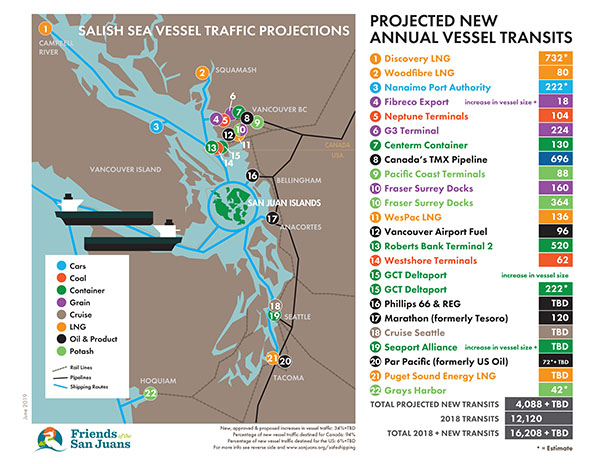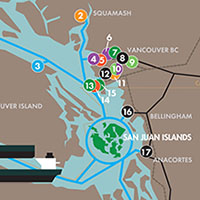— from Katie Fleming for Friends of the San Juans —
Friends of the San Juans identifies an additional 2,044 ocean going vessels making 4,088 transits to and from ports in British Columbia and Washington State from 24 new or expanding proposals.
Vessel traffic from ocean-going oil tankers, container ships, bulk cargo carriers, and liquefied natural gas carriers could increase 34% according to new information which appears in the updated Salish Sea Vessel Traffic Projections infographic available atwww.sanjuans.org/safeshipping.

“All these projects have one thing in common; increased air and noise pollution that could affect the Southern Resident orcas ability to communicate, socialize and successfully hunt for scarce prey. More disturbance means these starving animals will work harder to catch food, further depleting their reserves and releasing toxins in their bodies. A major oil spill from propulsion fuel from any one of these vessels could cause the Southern Residents’ extinction and impact our economy,” said Stephanie Buffum, Executive Director of Friends of the San Juans.
Friends of the San Juans has been monitoring new and expanding terminal and refinery projects throughout the Salish Sea for five years; sharing these vessel traffic projections at transboundary forums and conferences, and informing the public and decision-makers about the need for more cumulative impact analyses to address the necessary protection of our water, wildlife, and coastal communities.
The Salish Sea Vessel Traffic Projection infographic was included in recent testimony by Friends of the San Juans in Victoria, BC, to the Commission of the Canadian Environmental Assessment Agency regarding the proposed Roberts Bank Terminal 2 and to the U.S. Federal Government regarding the Navy’s Draft Northwest Training and Testing Supplemental Environmental Impact Statement/Overseas Environmental Impact Statement.
In 2018 there were 12,120 large, commercial ocean-going vessel transits in the Salish Sea. These vessel transits don’t include local barge traffic, anchoring, cueing, and/or bunkering (ship fueling) transits; or the many ferry boat transits, and the pleasure, fishing, and small commercial boats that share these transboundary waterways. 94% of the projected commercial vessel traffic is destined for Canada.
Approval of the Canadian Federal Government’s Trans Mountain Pipeline expansion will increase tanker traffic exporting tar sands diluted bitumen, increasing the likelihood of a 660,450 gallon or larger spill over the next ten years in Haro Strait and Boundary Pass by 800%.
“A majority of these projects are in Canada. We can’t look at these project applications alone. Their cumulative impacts of underwater noise, air pollution, and oil spill risk threaten our economy, environment, and culture of the Salish Sea,” added Buffum.
Friends of the San Juans is a public interest non-profit based on San Juan Island since 1979 with the mission to protect and restore the San Juan Islands and Salish Sea for people and nature. For more information: www.sanjuans.org/safeshipping.
**If you are reading theOrcasonian for free, thank your fellow islanders. If you would like to support theOrcasonian CLICK HERE to set your modestly-priced, voluntary subscription. Otherwise, no worries; we’re happy to share with you.**









Why can’t Canadian shippers send some of this traffic north, through Seymour Narrows, rather than south through the critical habitat of our endangered Southern Resident Killer Whales? Has anyone seriously asked this question? Or tried to answer it?
The more serious question is why are we not transitioning out of the oil economy, when the fate of mankind is at stake?
We keep producing larger and larger populations, both in the Lower 48, and in once-predominantly-rural Alaska. Canada’s population is growing, too.
All these people want stuff: Cars, refrigerators, TVs, PlayStations, computers, bicycles, and on, and on, and on.
How do the people north of us get all this stuff? Why, in ship-transported containers, that’s how.
And the same goes for gasoline, diesel fuel, construction materials, and even prefabricated houses.
So if you want to reduce shipping traffic in the Salish Sea, and beyond, maybe the first thing might be to consider finding ways to let the population become smaller.
The result of such an effort won’t be immediate, but, in time, it’ll do a lot to save those whales from noise pollution, oil pollution, and collisions with ships.
Fewer people will eventually mean more salmon for the Killer Whales, too.
Lets practice a little, um, population control.
Our gas combustion clown cars are no longer status symbols.